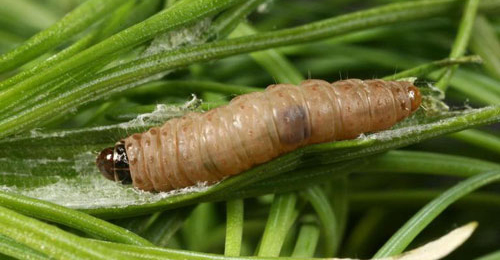|
||||||
|
Spilonota
laricana (Heinemann, 1863) Larch-bud Moth Grapholitha
lariiana
Heinemann, 1863 |
|||||||||||||||||||||||||||||||||||||||||||||||||||||||||||||
|
Leaf-miner: In Belgium the larva feeds at first between some needles of Larix spun together. It has been observed also on Picea sitchensis. After hibernation it feeds in the expanding buds. Pupation in the larval feeding place (Belgian Lepidoptera). In late summer the larva spins a few needles together, and mines them out. The larva hibernates between some mined needles that haven been spun together. After hibernation the larva bores into a developing bud, eventually pupating there (Bladmineerders van Europa). Larva: The larvae of moths have a head capsule and chewing mouthparts with opposable mandibles (see video of a gracillarid larva feeding), six thoracic legs and abdominal legs (see examples). The larva is illustrated in Bladmineerders van Europa.
Pupa: The pupae of moths have visible head appendages, wings and legs which lie in sheaths (see examples). See Patocka and Turcáni (2005a) (Bladmineerders van Europa). Adult: The adult is illustrated in UKMoths. The species is not included in mothdissection.co.uk. Hosts in Great Britain and Ireland:
Hosts elsewhere:
Time of year - larvae: Currently unknown. Time of year - adults: June and August (UKMoths). Distribution in Great Britain and Ireland: Britain including Banffshire, Bedfordshire, Dumfrishire, Durham, East Cornwall, East Norfolk, East Suffolk, Glamorgan, Hertfordhsire, Huntingdonshire, Middlesex, North Northumberland, Shropshire, Stafford, West Gloucestershire, West Norfolk, West Suffolk and Worcestershire (NBN Atlas). Also recorded in the Republic of Ireland (Fauna Europaea and National Biodiversity Data Centre Map). Distribution elsewhere: Widespread in continental Europe including Austria, Belgium, Czech Republic, Danish mainland, Estonia, Finland, French mainland, Germany, Hungary, Italian mainland, Latvia, Liechtenstein, Lithuania, Luxembourg, Norwegian mainland, Poland, Romania, Russia - Central, Slovakia, Slovenia, Sweden, Switzerland and The Netherlands. Also recorded in East Palaearctic (Fauna Europaea). NBN Atlas links to known host species:
British and Irish Parasitoids in Britain and elsewhere:
|
|||||||||||||||||||||||||||||||||||||||||||||||||||||||||||||
|
|
|
| External links: | Search the internet: |
| Belgian Lepidoptera Biodiversity Heritage Library Bladmineerders van Europa British leafminers Encyclopedia of Life Fauna Europaea NBN Atlas NHM UK Checklist UKMoths |
Find
using Google Find using Google Scholar Find images using Google |
| Last updated 11-Jul-2019 Brian Pitkin | ||

